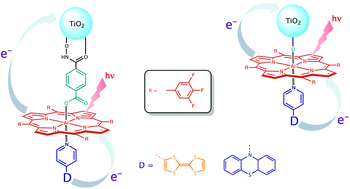Surface anchored self-assembled reaction centre mimics as photoanodes consisting of a secondary electron donor, aluminium(iii) porphyrin and TiO2 semiconductor†
Abstract
A series of vertically assembled photoanodes, consisting of 5,10,15,20-tetrakis(3,4,5-trifluorophenyl)aluminum(III) porphyrin (AlPorF3), a pyridine appended electron donor (PTZ-Py, PTZ = phenothiazine; TTF-Py, TTF = tetrathiafulvalene), and semiconductor TiO2, have been fabricated by exploiting the unique axial properties of AlPorF3. The new photoanodes were characterized by steady-state and transient spectroscopic techniques. Transient-absorption studies show that in the absence of a donor, both the photoanodes (AlPorF3–TiO2 and AlPorF3-Ph–TiO2) exhibit electron injection from AlPorF3 into the conduction band of TiO2 and the injection efficiencies are strongly dependent on the linker. Faster electron injection and recombination is revealed when AlPorF3 is directly bound to TiO2. Although a secondary electron donor is coordinated to AlPorF3 (viz., Donor-Py-AlPorF3–TiO2 and Donor-Py-AlPorF3-Ph–TiO2), the primary charge separation occurs in the form of electron injection from AlPorF3 to TiO2 followed by a secondary process involving photooxidation of the donor (PTZ and TTF) with AlPorF3˙+. The estimated electron injection lifetimes and the AlPorF3˙+ decay lifetimes strongly depend on the electron richness of the donor; the higher the electron density of the donor, the faster the electron injection and photooxidation witnessed. The photoanodes with TTF (TTF-Py-AlPorF3–TiO2 and TTF-Py-AlPorF3-Ph–TiO2) show faster injection and shorter decay lifetimes of AlPorF3˙+ over their PTZ counterparts (PTZ-Py-AlPorF3–TiO2 and PTZ-Py-AlPorF3-Ph–TiO2). The observed trends suggest that the strong secondary electron donor enhances the injection and the subsequent photooxidation processes in the investigated photoanodes. The successful mimicking of a sequential charge-separation process makes aluminum(III) porphyrins potential sensitizers for the construction of photoanodes, especially for photocatalytic and dye-sensitized solar cells for conversion and storage of solar energy.

- This article is part of the themed collection: PCCP Editor’s Choice, 2020


 Please wait while we load your content...
Please wait while we load your content...